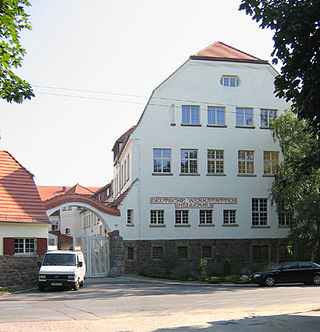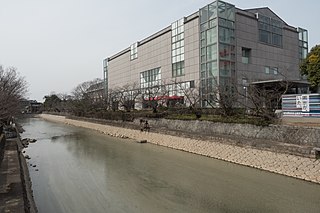
The Deutscher Werkbund is a German association of artists, architects, designers and industrialists established in 1907. The Werkbund became an important element in the development of modern architecture and industrial design, particularly in the later creation of the Bauhaus school of design. Its initial purpose was to establish a partnership of product manufacturers with design professionals to improve the competitiveness of German companies in global markets. The Werkbund was less an artistic movement than a state-sponsored effort to integrate traditional crafts and industrial mass production techniques, to put Germany on a competitive footing with England and the United States. Its motto Vom Sofakissen zum Städtebau indicates its range of interest.

Ryohin Keikaku Co., Ltd., or Muji is a Japanese retail company which sells a wide variety of household and consumer goods. Muji's design philosophy is minimalist, and it places an emphasis on recycling, reducing production and packaging waste, and a no-logo or "no-brand" policy. The name Muji is derived from the first part of Mujirushi Ryōhin, translated as No-Brand Quality Goods on Muji's European website.

Gebrüder Thonet or the Thonet Brothers was a European furniture manufacturer. It continues as a German company, Austrian and Czech (TON).

The Pinakothek der Moderne is a modern art museum, situated in central Munich's Kunstareal.

Lilly Reich was a German designer of textiles, furniture, interiors, and exhibition spaces. She was a close collaborator with Ludwig Mies van der Rohe for more than ten years during the Weimar period in the 1920s and early 1930s. Reich was an important figure in the early Modern Movement in architecture and design. Her fame was posthumous, as the significance of her contribution to the work of Mies van der Rohe and others with whom she collaborated only became clear through the research of later historians of the field.

Richard Riemerschmid was a German architect, painter, designer and city planner from Munich. He was a major figure in Jugendstil, the German form of Art Nouveau, and a founder of architecture in the style. A founder member of both the Vereinigte Werkstätte für Kunst im Handwerk and the Deutscher Werkbund and the director of art and design institutions in Munich and Cologne, he prized craftsmanship but also pioneered machine production of artistically designed objects.

The National Museum of Modern Art, Kyoto is an art museum in Kyoto, Japan.

</ref></ref>

Objectified is a feature-length documentary film examining the role of everyday non-living objects and the people who design them, in our daily lives. The film is directed by Gary Hustwit. Objectified premiered at the South By Southwest Festival on March 14, 2009.

Louise Schouwenberg studied psychology at the Radboud University Nijmegen, sculpture at the Gerrit Rietveld Academy in Amsterdam, and philosophy at the University of Amsterdam. She worked as a visual artist from 1985–2003. Since then her primary focus has been on art and design theory. Schouwenberg is head of the Masters programme Contextual Design at Design Academy Eindhoven, and mentor of the Masters programme Inside, Interior Architecture, of the Royal Academy of Arts in The Hague.

Hella Jongerius is a Dutch industrial designer.

Design Museum Gent is a museum in Belgium with an international design collection. The museum complex is located in the tourist centre of Ghent and comprises an 18th-century mansion and a modern wing. The museum holds a collection of Belgian design, supported by international objects.

Konstantin Grcic, born 1965, is a German industrial designer known for creating mass-manufactured items, such as furniture and household products. He has participated in leading design shows and his work can be seen in major museums. Described as having a pared down aesthetic, his functional designs are characterized by geometric shapes and unexpected angles.
Belgrade Design Week is an international festival established in 2005, and held once a year in Belgrade, Serbia. The week-long conference is organized every spring and is the largest design initiative in South-Eastern Europe. It covers architecture, design, fashion, publishing, and new media, as well as related fields like communications, marketing, advertising, and arts management. The event includes design labs, competitions, and presentations from international speakers like Karim Rashid and Daniel Libeskind.

Wiebke Siem is a German mixed media artist of German and Polish heritage, winner of the prestigious Goslarer Kaiserring in 2014 as "one of the most innovative and original artists who has never compromised in their art and whose sculptures have a tremendous aura and presence because they mix the familiar and the unfamiliar, the known and the unknown".

Martin Rendel is a German cultural manager and university professor. Innovation through intercultural and interdisciplinary cooperation is the main focus of his work.
Max Creutz was a German art historian and curator of the Museum für Angewandte Kunst Köln and the Kaiser-Wilhelm-Museum in Krefeld where he worked from 1922 until his death. In Cologne, in 1914 he was instrumental in the first exhibition of the Deutscher Werkbund, Deutsche Werkbundausstellung. In Krefeld, he succeeded in acquiring modern art exhibits, including works by Max Ernst, Wassily Kandinsky, and Alexej von Jawlensky. He included a substantial collection of art, crafts and design from the Bauhaus.
















